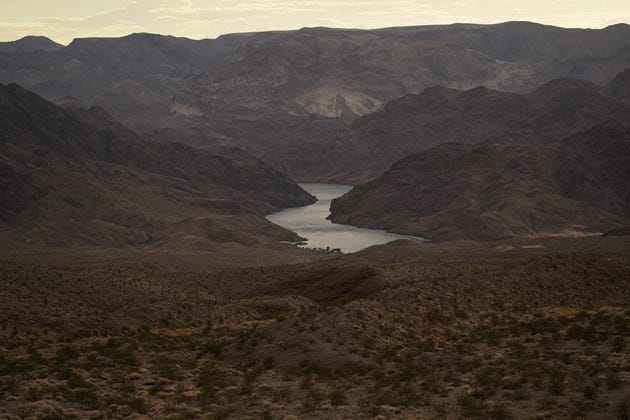Destabilized Saturday Edition #50
Water battles out west, "GO HIGHER!", Russian advent calendar, climate mitigation momentum and hope
On Monday, January 1st, the upscale Rio Verde Foothills community outside of Scottsdale, Arizona will have an important part of its water supply cut off. For years, Scottsdale sold water to a truck service that supplied water to about 500 of the 2,000 homes in the unincorporated area of Maricopa County. But the city, led by Mayor David Ortega, has decided that in light of the ongoing drought (which is more like a new baseline) it can no longer responsibly sell its water to non-residents.
Some Rio Verde Foothills homes get water from private wells, and presumably some homeowners losing water will drill their own. Others will borrow from neighbors or pay for water to be hauled from further away. No one in Rio Verde Foothills is going to die of thirst. What’s notable is the recognition among some elected leaders that they have to do everything possible to conserve water for their constituents, even when that means denying it to others.
In Arizona’s neighbor to the north, the town of Oakley, Utah reached a related conclusion in 2021 when they stopped issuing building permits for structures that needed to connect to the town water system. In explaining the town’s rationale, Mayor Wade Woolstenhulme noted his primary responsibility to the people who live there: “We’ve already told them we’d provide them with the water that they need to survive.”
—
Since the end of World War II, the United States has enjoyed a long and nearly uninterrupted period of prosperity. Of course, we regularly refuse to grant all Americans fair access to our national riches, leading to extreme inequality and high levels of poverty. But societally we have lived for generations with a broadly correct assumption of abundance. It has shaped our perceptions of the world and, in many ways, defined our national self-understanding. It helped produce the blithely confident mindset that leads us to build houses in a desert-like area without a dedicated water source.
Climate change will diminish elements of this abundance and, eventually, our assumption of its existence. We’re entering an era where there will often not be enough of all the things we need. Not enough water, not enough homes in climate durable places, not enough affordable insurance, not enough public funding to ruggedize all essential infrastructure or buy-out all the ruined homes. It’s going to be a gradual shift, but a painful one. (It’s a safe bet that the worst of it will be borne by those at the bottom of the economic ladder.)
—
I’m not sure how many people see this change of eras coming, but there are two mayors out west who realize they’re now operating in a context of scarcity, at least when it comes to water. They won’t be the last to see it, but this recognition will dawn slowly. Many will noisily dissent, refusing to concede the world has changed.
Discontinuity is always hard to see coming, even when it has already started to arrive.
My Work
Struggling to see what is right in front of us (link)
The most interesting lesson of the housing market crash is this: it is difficult to see change coming when it represents a discontinuity with the past. This difficulty is so great, in fact, that despite indicators like rising mortgage default rates, and despite strong financial incentives to see the market objectively, most investors failed to see the housing crash coming. They failed in large part because what happened didn’t fit in their mental model of how the world works.
Interesting Reads
From Climate Exhortation to Climate Execution (link)
For instance, Rewiring America estimates that the country needs a million new electricians just to do the new wiring that will be needed. According to Evans-Brown, the largest solar company in New Hampshire has “taken their entire marketing team and said, ‘Stop selling solar panels, they’re selling themselves.’ Instead, the whole marketing team is now devoted to recruiting electricians.”
Tweets of the Week
I like this video showing the subsurface dynamics of melting permafrost:

Extreme Weather Watch





Creeping Fascism Watch


Progress Joy and Hope














